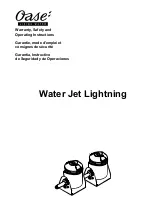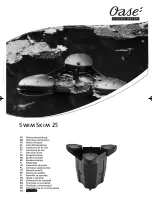
1.
INSTALLATION
IOM manual CTI & CTH centrifugal pumps
8
1.5.
Environment
There should be enough space in the vicinity of the pump in order to operate, maintain
and repair it.
The area in which the pump is operated, must be sufficiently ventilated. Excessive
temperature, humidity or dirt may affect the pump operation.
Behind the cooling fan of the motor there must be sufficient room for the hot air to
escape the motor.
1.6.
Suction and discharge piping
A pump is generally part of a piping system that can include a number of components such
as valves, fittings, filters, expansion joints, instruments, etc. The way the piping is arranged
and the positioning of the components has a great influence on the operation and the
lifetime of the pump. The pump cannot be used as a support for the components connected
to it.
The flow of liquid from the pump must be as even as possible. It is advisable to avoid any
tight bends or drastic reductions of diameters that may cause flow resistance in the
installation. In case of diameter reduction, it is advisable to use appropriate conical
reductions (possibly eccentric on suction side and concentric on discharge side) at changes
of diameter and at a minimum distance from pump connections of five diameters.
1.6.1.
Connection of discharge pipe
A check-valve and a shut-off/regulation valve are normally fitted on the discharge side.
The check-valve protects the pump from any backflow. The shut-off/regulation valve cuts off
the pump from the line and adjusts the output. Never adjust flow rate using the valve on the
suction pipe.
1.6.2.
Connection of suction pipe
The suction piping is very important for the correct operation of the pump assembly. It must
be as short and as direct as possible. If a longer suction line is unavoidable, the diameter
should be large enough, i.e. at least as the inlet connection on the pump, to ensure less flow
resistance. In any case, suction must be carried out properly avoiding any air locks.
The CT pumps are single-stage centrifugal pumps, thus not self-priming. It will therefore
always be necessary to install a bottom valve in all cases when the static height of the liquid
is lower than the suction height of the pump. It is also crucial that the whole suction line is
filled with liquid prior to starting the pump. The suction piping must be air tight. Critical
points in these terms are also the seals between flanges and the seals of the valve stems.
Even some small air let into the suction line cause serious operating problems that can make
the pump stop. It is recommended to use check-valve in the suction line to avoid siphoning
when the pump stops.









































